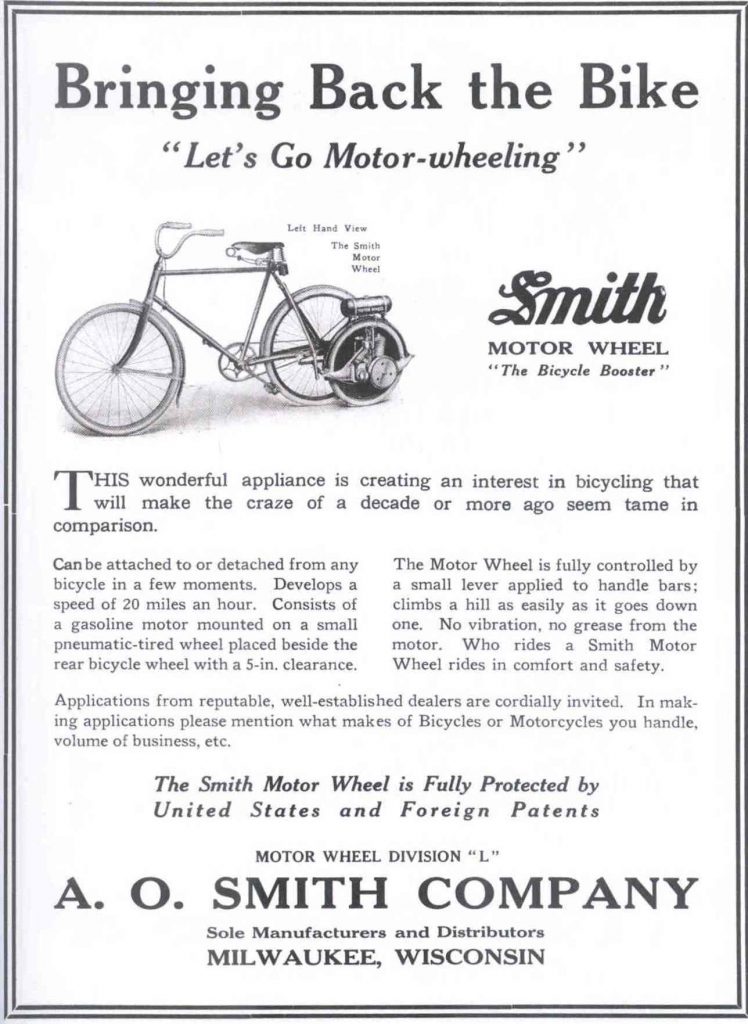The Smith Motor Wheel-A Restoration From The Heart
 The founder of Smith Precision Products Company, Reuben Stanley Smith, filed seven patents between the years 1914 and 1917 for a device he called a Motor Wheel for Bicycles. The first patent (1,373,918) was filed on August 20, 1914. This occurred when Reuben was the Chief Engineer of the A.O. Smith Corporation in Milwaukee, Wisconsin (see Family Legacy on the Smith Pumps homepage, years 1914-1915). It was at a time when L.R. Smith was managing the A.O. Smith Corporation. L.R. Smith was Reuben’s first cousin and son of A.O. Smith, the founder of the A.O. Smith Corporation. A.O. Smith passed away in 1913.
The founder of Smith Precision Products Company, Reuben Stanley Smith, filed seven patents between the years 1914 and 1917 for a device he called a Motor Wheel for Bicycles. The first patent (1,373,918) was filed on August 20, 1914. This occurred when Reuben was the Chief Engineer of the A.O. Smith Corporation in Milwaukee, Wisconsin (see Family Legacy on the Smith Pumps homepage, years 1914-1915). It was at a time when L.R. Smith was managing the A.O. Smith Corporation. L.R. Smith was Reuben’s first cousin and son of A.O. Smith, the founder of the A.O. Smith Corporation. A.O. Smith passed away in 1913.
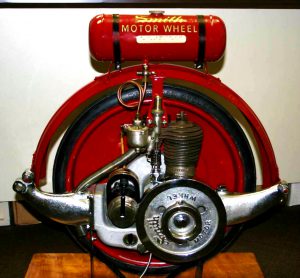
The motor wheel was a simple device using a small internal combustion engine (about 1-1/2 hp) to drive a 20-inch wheel with pneumatic tire. The engine/wheel combination was mounted to the left side of the rear tire of just about any type of bicycle and would enable the rider to travel up to 20 mph. The gas tank held one gallon of gasoline, good for about 100 miles.
Roughly 25,000 motor wheels were produced by the A.O. Smith Corporation between the end of 1914 and the middle of 1919 before the manufacturing rights and patents were sold to the Briggs and Stratton Corporation. Briggs and Stratton continued to manufacture the motor wheel under their name for a few more years. Today, both the Smith and Briggs and Stratton motor wheels are collector items. A rather remarkable group of collectors have restored them and continue to find old motor wheel relics in buildings and barns across the country. They are very rare.
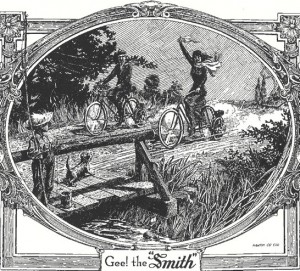
After Reuben moved to California in 1922, he immersed himself in his work with meters and later with liquefied gas pumps. He passed away more than three decades after designing the Smith Motor Wheel, long after the Briggs and Stratton Corporation ceased to make them any longer. Nearly six decades after Reuben passed away, his work with the motor wheel and other remarkable designs were discovered in several of his files that had been in storage for nearly one hundred years. It was an astonishing discovery made by one of his grandsons and President of Smith Precision Products Company, Walter W. Smith. This article is written to celebrate that discovery and describe how the Smith Motor Wheel reunited a segment of the Smith family that did not know of the existence of one another.
Several months ago, a letter was received from Mark Alt who lives in Florida. The letter advised he was married to a relative of A.O. Smith (founder of the A.O. Smith Corporation) and was in the process of restoring a Smith Motor Wheel as a surprise for his wife. He had been on the Smith Precision Products Company website and was inquiring about some memorabilia shown on the site specific to the motor wheel (see Family Legacy, years 1914-1915). To make a long story short, as it turns out, Mark is married to one of A.O. Smith’s great granddaughters. Her grandfather was L.R. Smith who Reuben was working for when the Smith Motor Wheel was designed and produced. Walter Smith began corresponding with Mark and a relationship developed.
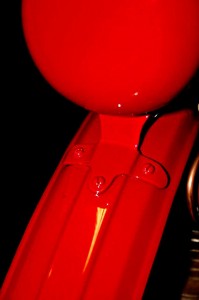
During the course of conversation, Mark relayed he was having difficulty finding some parts for his restoration. Seeing as many motor wheels were scrapped because of WWI and WWII, or the engines were removed from the wheel to drive some sort of farm or machine shop implement, and simply because they were made nearly 100 years ago, finding parts is a major problem. One component of the Smith Motor Wheel that is difficult to find is the actual wheel itself.
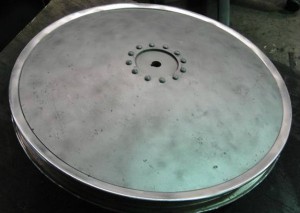
The wheel is made from sheet metal discs that must be riveted onto a hub. The finished wheel is then mounted by securing the hub onto the tapered cam shaft with a left-hand threaded nut. Mark contacted Dave Bagne in Minnesota that could make the wheel for him but he needed the hub. Walter offered to make a new hub for Mark and to produce CAD drawings of other parts so they could be made in the future, if required. So began a two month long process that would not only involve one of Reuben’s grandsons, Walter, but also involve one of his great grandsons, C.J. Smith.
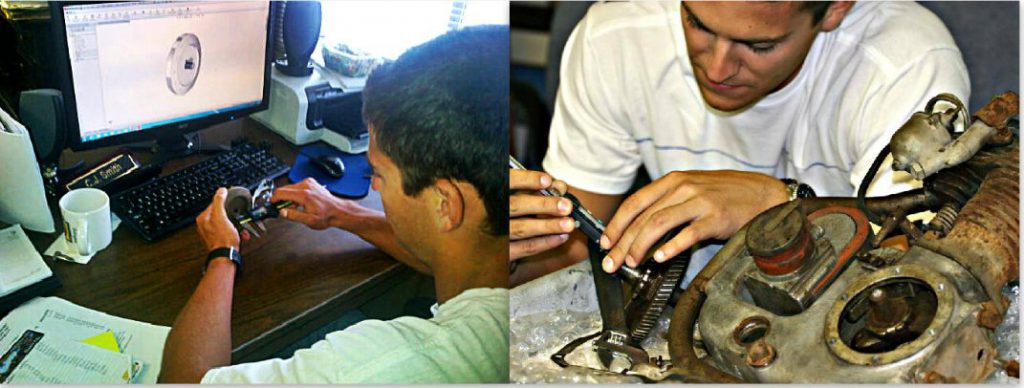
C.J. is Walter’s son and a recent graduate mechanical engineer that just started working for the company. He reverse engineered his great grandfather’s components supplied by Mark and proceeded to produce CAD drawings in Solid Works™. Once completed, Jack Bowers, who is Smith’s Plant Manager, wrote CNC programs and began the tedious job of manufacturing a one-of-a-kind component.
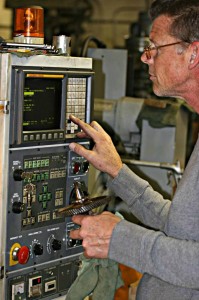
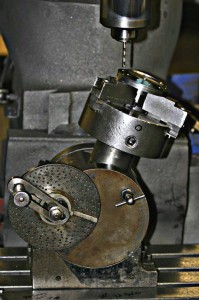
One of the issues that arose from this was the angle of one of the hub faces. Twelve rivet holes must be drilled into this face, perpendicular to it. To complete this operation, a very old table indexer was taken out of mothballs. It is an indexer Reuben Stanley Smith purchased many decades ago and used for his prototype work. It still functioned like a charm.
Mark and Walter came to the conclusion that this hub could be the first “semi-original” Smith Motor Wheel part produced in nearly one hundred years. Reuben never would have imagined one of his grandsons, let alone one of his great grandsons, would ever reverse engineer one of his designs and manufacture it, after he filed the original patent in 1914.
As Mark’s side of the Smith family did not know the California Smiths existed, and they had no idea Mark’s family existed, it was the Smith Motor Wheel, after almost one hundred years, that brought them together.
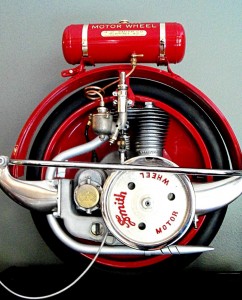
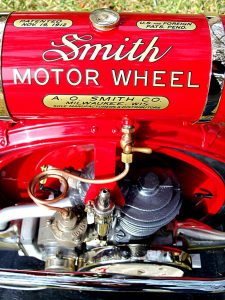
We are more than grateful to the Smith Motor Wheel enthusiasts and those that plough everything they have into restoring this wonderful piece of American history. One such enthusiast is Bob Kelly who lives in Lompoc, California. Bob is truly an engine expert and recently loaned his Smith Motor Wheel to Walter so measurements could be taken from some key components (especially the hub) which enabled Smith Precision Products Company to make the parts for Mark Alt’s Smith Motor Wheel. Bob’s Smith Motor Wheel was recently restored by Gabe Ferrie of Whitney Garden, California, and is a masterful example of time and patience.
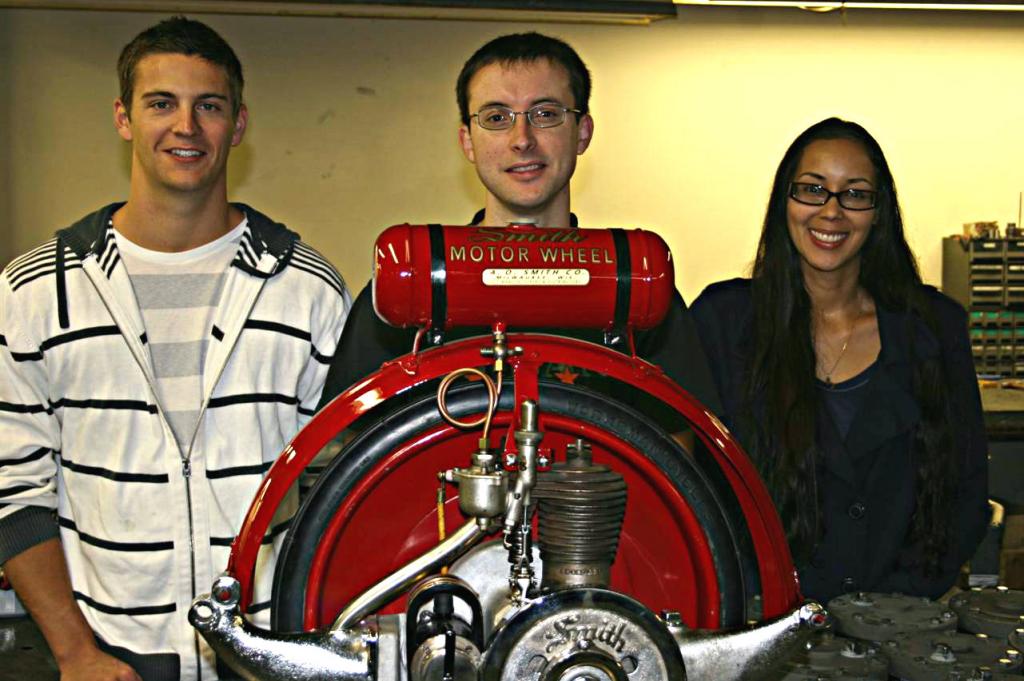
The Smith family graciously thanks Mark Alt and Bob Kelly.
Who Made the Smith Motor Wheel a Success
Little if any mention is ever made about the individuals responsible for the development of the Smith Motor Wheel. Here is a list of those working for the Smith Motor Wheel Division of the A.O. Smith Corporation directly involved with the success of the Smith Motor Wheel:
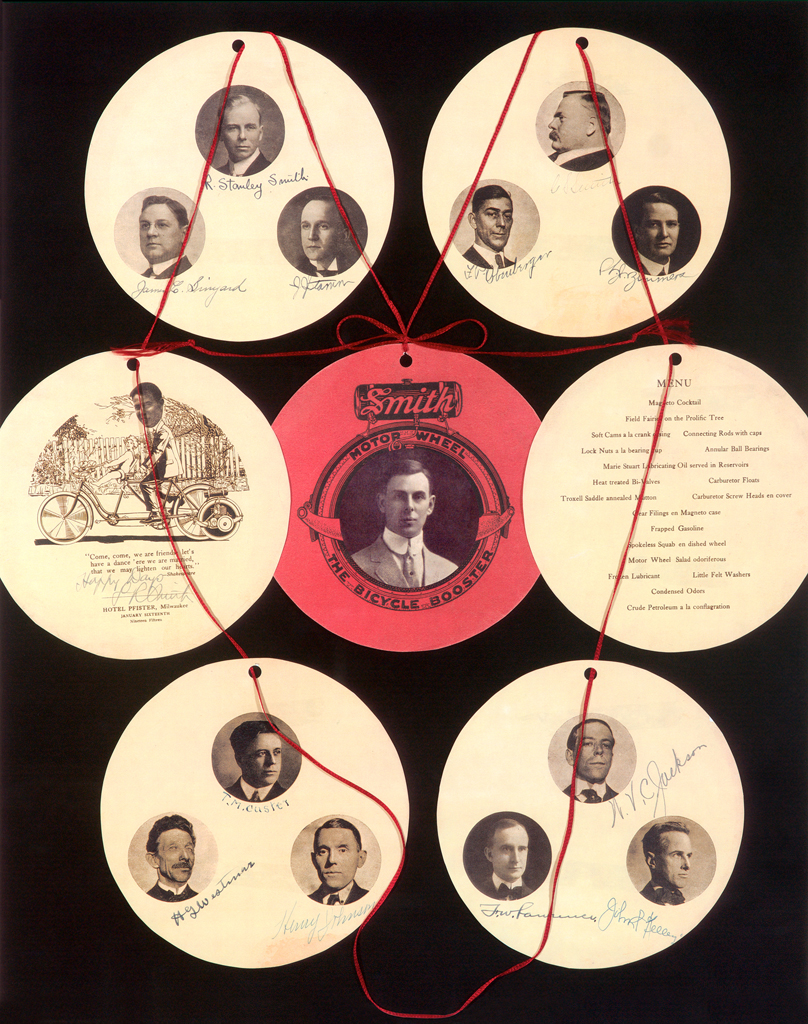
L.R. Smith was the President and a remarkable visionary.
J.L. Sinyard, J.J. Stamm, John Kelly, and C.S. Smith were company Directors in 1914. J.J. Stamm remained with the company in this position through at least 1938. C.S. Smith was a brother of A.O. Smith and Alonzo Smith (Reuben’s father; see year 1886 Smith Family legacy time-line). All three were sons of C.J. Smith (see Family Legacy, year 1837).
F.W. Lawrence was the assistant sales manager (beginning in 1908) and also a graduate engineer (1906; University of Wisconsin). In 1920 he was managing the A.O. Smith office in Detroit and in 1922 was a sales rep for the A.O. Smith Co. and Briggs and Stratton.
W.V.C. Jackson was the general manager from 1914 through 1916. In 1917 he resigned and was appointed comptroller of the Briscoe Motor Corporation.
Reuben Stanley Smith was the Chief Engineer and designer of the Smith Motor Wheel. His career with the A.O. Smith Corporation in Milwaukee began in 1909 and ended in 1922 when he moved to California.
T.M. Custer was a well known steel expert and managed the Company’s purchases.
W.J. Zimmers (Baker & Zimmers) was the company’s primary legal counsel and in 1916 was a District Governor for the International Association of Rotary Clubs.
F.P. Obenberger was the general superintendent of machine operations. He resigned in 1918 to take-up a position with Briggs and Stratton as Works Manager.
All of the above were instrumental in the design and marketing of the Smith Motor Wheel and were honored at a Smith Motor Wheel “send-off” dinner party at the Hotel Pfister in Milwaukee on January 16, 1915 (see Smith Family Legacy timeline, year 1915). It was after that date the company put forward a major marketing campaign to sell the Smith Motor Wheel through the middle of 1919. It was a resounding success.
